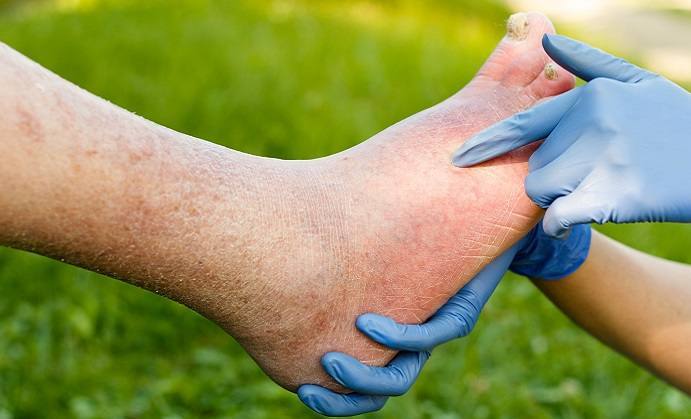Have you noticed a change in a toenail’s condition or color? Maybe it’s growing darker or you see white marks, or worse, maybe the toe smells bad. Maybe the nail is growing progressively thicker and harder to trim. You might even find it painful to walk in shoes.
These are all warning signs of onychomycosis, or toenail fungus, an infection caused by fungi taking hold under the nail. Some cases also involve bacterial or yeast infections.
How do you get it?
 You make yourself receptive to this kind of infection by walking barefoot in damp or wet areas such as public shower rooms and around swimming pools.
You make yourself receptive to this kind of infection by walking barefoot in damp or wet areas such as public shower rooms and around swimming pools.
A history of athlete’s foot, a problem of more than ordinary foot perspiration, or prior damage to a nail may contribute to the problem. People with ongoing health conditions such as diabetes, immune-related issues, or circulatory difficulties are especially at risk.
Is it serious?
People sometimes ignore the warning signs because toenail fungus doesn’t always cause pain, and, let’s face it, these infection can be embarrassing. But it’s smart to seek help as soon as possible. Left unchecked, toenail fungus can gradually worsen, and the infection could spread to other toenails, to your skin, or even to your fingernails.
How is it treated?
 What to do? Sometimes daily washing, along with applying an over-the-counter product, can subdue the infection for a short time. But the problem is the infection may return. Your best chance of resolving an infection is to seek the advice of a podiatrist as soon as you notice discoloration or thickening of a nail.
What to do? Sometimes daily washing, along with applying an over-the-counter product, can subdue the infection for a short time. But the problem is the infection may return. Your best chance of resolving an infection is to seek the advice of a podiatrist as soon as you notice discoloration or thickening of a nail.
Podiatrists offer a variety of options and medications. Treatment will depend on the type of infection and how severe it is when diagnosed. Doctors begin by doing a culture. Then they can recommend the best therapy for the specific condition.
For example, an oral antifungal medication may be an option. Or the doctor may recommend a topical medication, which can also be effective. In some situations a podiatrist may need to remove diseased matter, or temporarily remove some of the nail to allow a topical treatment to reach the infection. Cases where an infection does not respond to other treatments may require permanent removal of the nail.
How can you avoid it?
You can do a lot to avoid toenail fungus by keeping your feet clean and dry. Wear shower shoes when walking in public places like pools. And when you shower, don’t overlook your feet. Wash them with a good soap and water, and dry them well before dressing.
 Choose shoes that aren’t too tight, and those made from breathable materials are best. The goal is to keep your feet as dry as possible during the day.
Choose shoes that aren’t too tight, and those made from breathable materials are best. The goal is to keep your feet as dry as possible during the day.
Pay attention to your socks and hosiery. Help reduce moisture by avoiding tight fitting items, and choose synthetic fibers because they help draw moisture away from the body. Use clean socks and hosiery each time you dress.
Clip your toenails by cutting them straight across and so they are no longer than the end of your toe. Disinfect your toenail clippers before using them, and don’t apply nail polish to a nail that might be infected.
Do you want to find an effective Nail Fungus treatment? Check out our top rated Nail Fungus products











